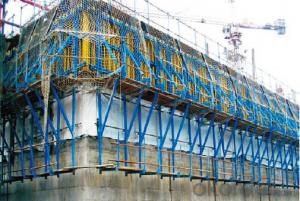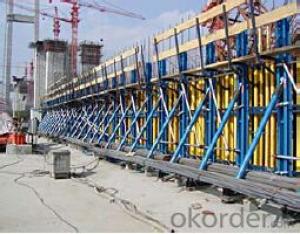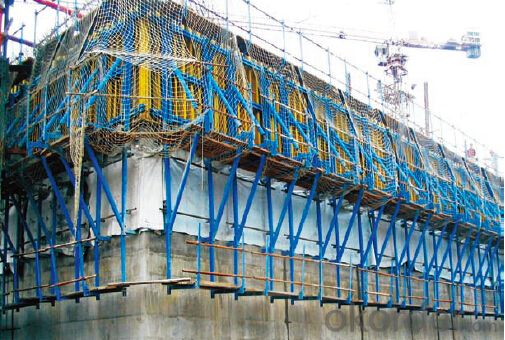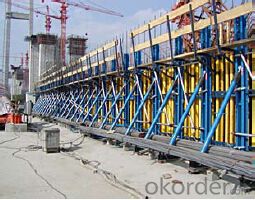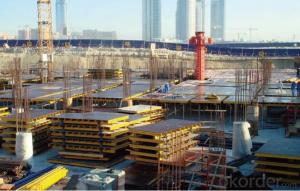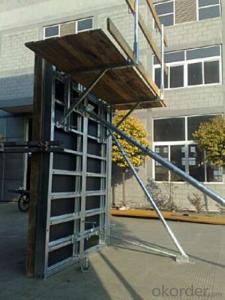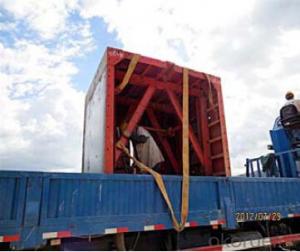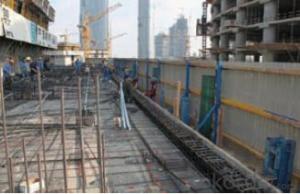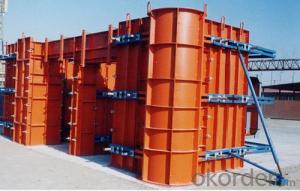Single-side climbing bracket SCB40 for formwork and scaffolding systems
- Loading Port:
- Tianjin
- Payment Terms:
- TT OR LC
- Min Order Qty:
- 50 m²
- Supply Capability:
- 1000 m²/month
OKorder Service Pledge
OKorder Financial Service
You Might Also Like
Single-side Climbing Bracket SCB180:
With CNBM SCB 180 climbing systems, the loads from the fresh concrete pressure are
transferred through the brackets by means of V-strongbacks and compression braces into the
scaffold anchors.
Typical applications for the SCB 180 are dams, locks, cooling towers, pier heads, tunnels, and
bank vaults.
The formwork is simply tilted backwards when striking takes place. The 1.80 m wide bracket
requires only a minimum of space.
Characteristics:
◆ Economical and safe anchoring
The M30/D20 climbing cones have been designed especially for single-sided concreting using
SCB180 in dam construction, and to allow the transfer of high tensile and shear forces into the still
fresh, unreinforced concrete. Without wall-through tie-rods, finished concrete is perfect.
◆ Stable and cost-effective for high loads
generous bracket spacings allow large-area formwork units with optimal utilization of the bearing
capacity. This leads to extremely economical solutions.
◆ Simple and flexible planning
With SCB180 single-sided climbing formwork, circular structures can also be concreted without
undergoing any large planning process. Even use on inclined walls is feasible without any special
measures because additional concrete loads or lifting forces can be safely transferred into the
structure.
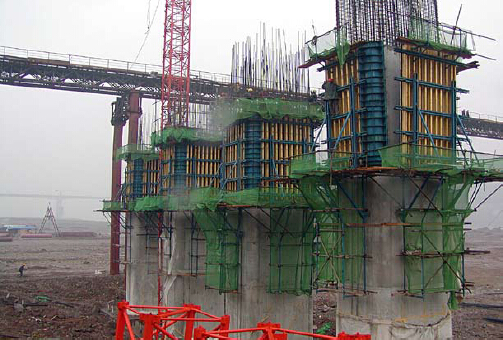
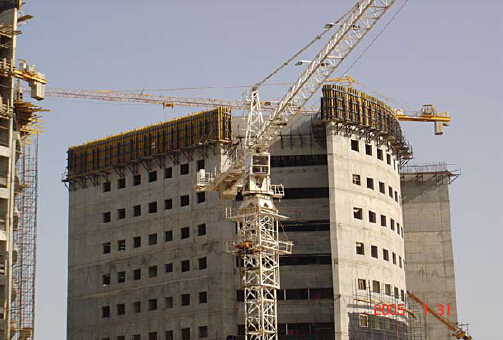
- Q: How does steel formwork handle formwork repositioning?
- Steel formwork is highly durable and flexible, making it ideal for handling formwork repositioning. Its sturdy construction allows for easy dismantling, transportation, and reassembly in new locations. Steel formwork systems typically consist of modular panels that can be easily adjusted and reconfigured to accommodate different shapes and sizes of concrete structures. This versatility and adaptability make steel formwork a preferred choice in construction projects where formwork repositioning is required.
- Q: How are steel formwork systems assembled and disassembled?
- Steel formwork systems are assembled and disassembled using a simple and efficient process. The assembly starts by erecting the steel panels, which are designed to interlock with each other through various connecting devices such as pins, wedges, or clips. These panels come in different sizes and shapes to accommodate various construction requirements. To assemble the steel formwork system, the panels are aligned and connected together according to the desired shape and dimensions of the structure. The panels are typically secured using pins or wedges to ensure stability and prevent any movement during the concrete pouring process. Once the panels are properly connected, the next step involves installing the necessary support structures such as walers, props, and braces. These elements help to reinforce the formwork system and distribute the loads evenly. Walers are horizontal beams that connect the vertical panels, while props are adjustable vertical supports that provide additional stability. Braces are diagonal members that help in resisting lateral forces. During the concrete pouring process, the steel formwork system holds the wet concrete in place and provides the desired shape and finish to the structure. After the concrete has cured and gained sufficient strength, the dismantling process begins. To disassemble the steel formwork system, the props and braces are removed first, followed by the walers. Once the support structures are taken down, the panels can be easily detached from each other by removing the connecting devices. This can be done by either pulling out the pins or wedges or releasing the clips. The disassembly process is usually done systematically, starting from the top and moving downwards to ensure safety and prevent any accidental collapse. It is important to follow proper safety guidelines and use appropriate tools to avoid any damage to the formwork system or injury to the workers. In conclusion, steel formwork systems are assembled by connecting steel panels and installing support structures, while the disassembly process involves removing the support structures and disconnecting the panels. This systematic approach ensures a safe and efficient construction process, allowing for the reuse of the formwork system in future projects.
- Q: Can steel formwork be used for both small and large-scale concrete placements?
- Yes, steel formwork can be used for both small and large-scale concrete placements. Steel formwork is known for its strength and durability, making it suitable for various construction projects of different sizes. It can be easily assembled and dismantled, allowing for efficient and cost-effective use in both small and large-scale concrete placements. Additionally, steel formwork provides a smooth and consistent finish to the concrete surface, ensuring high-quality results regardless of the project size. Therefore, whether it is a small residential construction or a large-scale infrastructure project, steel formwork can be a reliable choice for concrete placements.
- Q: How does steel formwork contribute to the overall aesthetics of the structure?
- There are several ways in which steel formwork enhances the overall aesthetics of a structure. Firstly, it is renowned for its high-quality finish and smooth surfaces, which create sleek and visually pleasing concrete structures. The clean and uniform appearance achieved with steel formwork adds to the aesthetic appeal of the final product. Furthermore, steel formwork allows for greater design flexibility and creativity. Architects and designers can take advantage of the versatility of steel to create intricate shapes and curves that would be challenging with other formwork materials. This flexibility opens up possibilities for unique and attention-grabbing architectural features, enhancing the overall visual appeal of the structure. In addition, steel formwork provides a consistent and precise formwork system, resulting in accurate dimensions and sharp edges. This attention to detail contributes to the overall crispness and professionalism of the structure's aesthetics. Whether it's for exposed concrete walls, columns, or beams, steel formwork ensures a high level of precision and alignment, creating a polished and refined appearance. Moreover, steel formwork offers durability and longevity, making it an ideal choice for structures that require long-term aesthetics. Unlike other formwork materials that may deteriorate over time, steel is resistant to weathering, corrosion, and warping. This ensures that the structure maintains its aesthetic appeal for years to come, without compromising its structural integrity. Lastly, steel formwork promotes sustainability by being easily reusable, reducing waste. Construction companies can minimize their environmental footprint by using the same steel formwork for multiple projects. This emphasis on sustainability aligns with the modern design aesthetic that values eco-friendly practices, making steel formwork an attractive choice for architects and clients alike. To sum up, steel formwork contributes to the overall aesthetics of a structure through its high-quality finish, design flexibility, precise formwork system, durability, and sustainability. These factors combine to create visually appealing, sleek, and polished structures that stand out in their architectural beauty.
- Q: How long does steel formwork last?
- Steel formwork can last for a significantly long time, typically ranging from 10 to 20 years or more, depending on various factors such as maintenance, usage frequency, and quality of the steel.
- Q: What are the different finishes that can be achieved with steel formwork?
- Some of the different finishes that can be achieved with steel formwork include smooth finishes, textured finishes, patterned finishes, and exposed aggregate finishes.
- Q: Can steel formwork be used for underground construction projects?
- Yes, steel formwork can be used for underground construction projects. Steel is a durable and strong material that can withstand the pressure and conditions found in underground structures. It provides stability and support during the construction process and can be easily reused or recycled after the project is completed.
- Q: What are the common connection methods for steel formwork?
- The common connection methods for steel formwork include welding, bolting, and clamping. Welding is a popular method as it offers strong and permanent connections. It involves melting two steel components together to create a bond. However, welding requires skilled labor and specialized equipment. Bolting is another commonly used connection method for steel formwork. This method involves using bolts and nuts to join the steel components together. Bolting offers a flexible and adjustable connection, allowing for easy disassembly and reassembly of formwork panels. It is also a relatively quick method and does not require highly skilled labor. Clamping is a connection method that utilizes clamps or couplers to connect steel formwork components. This method is often used for temporary formwork structures or when quick assembly and disassembly are required. Clamping offers a flexible and adjustable connection, similar to bolting, but without the need for tools or additional hardware. Overall, the choice of connection method for steel formwork depends on various factors such as the project requirements, desired level of permanence, ease of assembly, and available resources. Each method has its advantages and disadvantages, and it is important to select the most suitable method based on the specific project needs.
- Q: What are the advantages of using modular steel formwork systems?
- There are several advantages of using modular steel formwork systems. Firstly, these systems are highly durable and can be reused multiple times, leading to cost savings in the long run. Secondly, they provide accurate and precise results, ensuring consistency in construction projects. Additionally, modular steel formwork systems offer flexibility and can be easily adjusted or customized to meet specific project requirements. They also enhance productivity as they can be quickly assembled and disassembled, saving time and labor. Moreover, these systems provide a smooth and high-quality finish to concrete structures. Overall, the advantages of using modular steel formwork systems include durability, cost-effectiveness, accuracy, flexibility, productivity, and superior finish.
- Q: What are the different types of tie systems used in steel formwork?
- There are several different types of tie systems that are commonly used in steel formwork in construction projects. These tie systems are designed to provide stability and support to the formwork during the concrete pouring process. Some of the main types of tie systems used in steel formwork include: 1. Tie rods and wing nuts: This is the most commonly used tie system in steel formwork. It consists of steel rods that are inserted through the formwork panels and secured with wing nuts. This system allows for quick and easy assembly and disassembly of the formwork. 2. Shear connectors: Shear connectors are used in situations where there is a need to transfer shear forces between the formwork and the concrete. These connectors typically consist of steel bars that are embedded in the concrete and connected to the formwork. 3. Steel form ties: Steel form ties are used to hold the formwork panels together and maintain the desired shape and alignment during concrete pouring. These ties are typically made of steel and are available in various lengths and sizes to accommodate different formwork requirements. 4. Adjustable formwork systems: These systems are designed to provide flexibility in adjusting the formwork to different shapes and sizes. They often incorporate adjustable brackets and clamps that allow for easy and precise alignment of the formwork panels. 5. Stay-in-place formwork systems: Stay-in-place formwork systems are designed to remain in place after the concrete has cured, eliminating the need for formwork removal. These systems are typically used in applications where the formwork is intended to become a permanent part of the structure, such as in bridges or tunnels. Overall, the choice of tie system in steel formwork will depend on factors such as the project requirements, structural design, and the specific conditions of the construction site. It is important to select a tie system that can provide the necessary stability and support for the formwork, while also considering factors such as ease of installation, reusability, and cost-effectiveness.
Send your message to us
Single-side climbing bracket SCB40 for formwork and scaffolding systems
- Loading Port:
- Tianjin
- Payment Terms:
- TT OR LC
- Min Order Qty:
- 50 m²
- Supply Capability:
- 1000 m²/month
OKorder Service Pledge
OKorder Financial Service
Similar products
Hot products
Hot Searches
